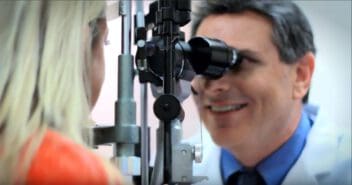Pterygium & Pinguecula Surgery Recovery Timeline
Home / Surfer’s Eye (Pterygium): Signs & Removal Options /
Last Updated:
Healing time after pterygium surgery depends somewhat on how much tissue was removed, your personal health and healing ability, and how well you follow the aftercare instructions. Typically, your eye is healed in about a month. Some people heal in less time, and it can take others a couple of months to fully return to normal.
After a few days, you can remove the eye patch. This will likely coincide with your first follow-up visit. During that visit or a second follow-up visit shortly after, your eye doctor will remove sutures if you received these instead of fibrin glue.
You will need a few weeks for your eye to return to its original color, with no redness or yellowed tissue. During this time, you will be able to see out of your eye, and your vision will improve further over the next few weeks. The day after surgery, your vision will be clear enough to work on a computer, read books, watch television, and drive safely.
You should avoid water and high-impact sports until your doctor informs you these are safe. “Water” includes showers. Avoid getting water in your eye for at least a month after the operation. This may require wearing an eye patch or goggles when you bathe.
Table of Contents
A discolored or fleshy bump in your eye is either a pinguecula or pterygium. Your optometrist or ophthalmologist can diagnose these conditions and recommend treatment, which may include surgery for a pterygium.
A pinguecula is not generally removed surgically, but it might turn into a pterygium, which can be removed from your eye. This may require a small tissue graft on your conjunctiva, and the choice of either sutures or surgical glue.
After pterygium removal surgery, it takes at least a month for your eye to look normal and healthy again. But you should be able to see well within a day or two after the pterygium is removed from your eye.
Always follow your doctor’s instructions after a surgery like pterygium removal. Avoid intense exercise or water in your eye, so your eye can heal as fast as possible.
Pinguecula & Pterygium: Surgery for Either Is Rare

When your eyes are exposed to too much ultraviolet (UV) light, too much wind, or too much dust, you may develop growths on your sclera, or the white part of your eye. There are two types of growths: a yellowish spot, which might be raised like a bump, called a pinguecula; and a flesh-like wedge or bump called a pterygium. Although both types of growth can look startling or disconcerting, they are both benign.
Eye doctors do not usually perform surgery on a pinguecula, but you may receive medicated eye drops if the bump causes itchiness or discomfort. These eye drops slow growth and relieve symptoms by keeping your eye sufficiently moist.
You deserve clear vision. We can help.
With 135+ locations and over 2.5 million procedures performed, our board-certified eye surgeons deliver results you can trust.
Your journey to better vision starts here.
Some pingueculae can turn into pterygia, which may be surgically removed. You might also develop a pterygium by itself, which you can choose to have surgically removed.
Pterygia rarely require surgery. Most people elect to have a pterygium removed because they do not like the way it looks. But sometimes, a pterygium can grow too close to the cornea, causing refractive errors by forcing this part of the eye into a different shape. A pterygium might also be uncomfortable, causing itching, pain, redness, and other symptoms. In these cases, your eye doctor will recommend pterygium surgery.
How Does Pterygium Surgery Work to Promote Healing?
There is no surgical treatment for pinguecula, but if this small, discolored spot turns into a pterygium, you can elect to have this fleshy growth removed from your eye. This procedure removes the pterygium from the conjunctiva, which is the clear tissue covering the inside of your eyelids and your sclera.
The procedure is minimally invasive, but still removes part of the outside of your eye. Sometimes, a doctor will replace this tissue, and sometimes, they will opt for the “bare sclera” technique.
When preparing for this surgery, your eye surgeon will ask you to:
- Stop wearing contact lenses for at least 24 hours in advance of the operation.
- Fast for several hours before the operation or only eat a light meal, to manage any sedatives you need.
- Arrange for someone to drive you home after the procedure.

Pterygium removal is an outpatient operation that takes between 30 and 45 minutes. During the operation, your surgeon will give you numbing eye drops. You might receive a mild sedative if you feel nervous because you will be awake during pterygium removal. This helps to shorten the recovery and healing timeline since you do not go under general anesthesia.
Your surgeon has two choices during pterygium removal, which can influence how your eye heals.
- Conjunctiva transplant vs. bare sclera: Depending on the size of the pterygium when it is removed, and if you have any other issues with your sclera, your eye surgeon may take some of the conjunctiva from another part of your eye, from your other eye, or from a tissue donor, and use that to replace the missing piece of conjunctiva.
The spot may be small enough that you do not need this tissue graft, so your surgeon may choose the “bare sclera” option. Using a conjunctiva graft reduces the risk of pterygium recurrence, while the bare sclera technique increases it slightly. - Sutures vs. fibrin glue: Sutures are less expensive, while fibrin glue (a type of surgical glue made from blood) does not need to be removed after a few days and will dissolve. Eye surgeons do not use dissolving sutures due to the discomfort this causes the eye as it heals.
There is a slightly higher risk of transmitting bloodborne diseases with fibrin glue. There is not an inherently better healing time with either option. Both reduce the risk of pterygia recurrence.
Once surgery is complete, you will be moved to a recovery room for about an hour, with an eye pad or patch over your eye to stop you from bumping or touching the area. You will also receive aftercare instructions.
You deserve clear vision. We can help.
With 135+ locations and over 2.5 million procedures performed, our board-certified eye surgeons deliver results you can trust.
Your journey to better vision starts here.
Recovery Time After Pterygium Surgery

Healing time after pterygium surgery depends somewhat on how much tissue was removed, your personal health and healing ability, and how well you follow the aftercare instructions. Typically, your eye is healed in about a month. Some people heal in less time, and it can take others a couple of months to fully return to normal.
After a few days, you can remove the eye patch. This will likely coincide with your first follow-up visit. During that visit or a second follow-up visit shortly after, your eye doctor will remove sutures if you received these instead of fibrin glue.
You will need a few weeks for your eye to return to its original color, with no redness or yellowed tissue. During this time, you will be able to see out of your eye, and your vision will improve further over the next few weeks. The day after surgery, your vision will be clear enough to work on a computer, read books, watch television, and drive safely.
You should avoid water and high-impact sports until your doctor informs you these are safe. “Water” includes showers. Avoid getting water in your eye for at least a month after the operation. This may require wearing an eye patch or goggles when you bathe.
After Pterygium Surgery, Follow Your Doctor’s Instructions
If you undergo pterygium removal surgery, follow all your eye doctor’s instructions to prepare and take care of yourself afterward. Healing may be improved with certain choices like sutures over surgical glue, or choosing a graft rather than bare sclera. Talk to your eye surgeon about these options and what they think the right process could be for you.
Although the overall healing process takes a couple of months, you should be able to see well out of your eye within a day or two after the operation.
You deserve clear vision. We can help.
With 135+ locations and over 2.5 million procedures performed, our board-certified eye surgeons deliver results you can trust.
Your journey to better vision starts here.
References
- Pinguecula and Pterygium (Surfer’s Eye) Treatment. (August 2019). American Academy of Ophthalmology (AAO).
- Six Things to Know About Pinguecula and Pterygium. (July 2016). American Academy of Ophthalmology (AAO).
- New Approach Emerges With Pterygium Surgery. (February 2012). American Academy of Ophthalmology (AAO).
- I Got A Pterygium Cut Out of My Eyeball, and I Learned These 20 Things. (July 7, 2015). The Inertia.com.
This content is for informational purposes only. It may have been reviewed by a licensed physician, but is not intended to serve as a substitute for professional medical advice. Always consult your healthcare provider with any health concerns. For more, read our Privacy Policy and Editorial Policy.
